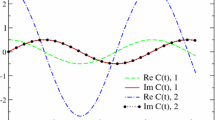Abstract
The combination of normal coordinate analysis with intensity calculations gives quantitative information about molecular force fields and the assignments of vibrational frequencies. Calculations of vibrational intensities by means of a standard CNDO/2 version give rise to satisfactory results for the IR intensities. However, the calculated Raman intensities often differ strongly from the experimental data. Inclusion of 2p-polarization functions on hydrogen in the usually used valence basis set is quite successful to obtain improved molecular polarizabilities as well as Raman intensities.
Similar content being viewed by others
References
Wilson Jr., E. B., Decius, J. C., Cross, P. C.: Molecular Vibrations, London: McGraw-Hill 1955
Placzek, G., in: Handbuch der Radiologie, Vol. VI, Part II, E. Marx (Ed.). Leipzig: Akad. Verlagsgesellschaft 1934
Janoschek, R., Stoll, H.: Nachr. Chem. Tech. Lab. 26, 720 (1978)
Pople, J. A., Beveridge, D. L.: Approximate molecular orbital theory. New York: McGraw-Hill 1970
Segal, G. A., Klein, M. L.: J. Chem. Phys. 47, 4236 (1967)
Bleckmann, P.: Z. Naturforsch. 29A, 1485 (1974)
Chantry, G. W., in: The Raman effect, Vol. 1, A. Anderson Ed. New York: Marcel Dekker 1971; Morino, Y., Kuchitsu, K., Takahashi, A., Maeda, K.: J. Chem. Phys. 21, 1927 (1953)
Meyer, H., Schweig, A.: Theoret. Chim. Acta (Berl.) 29, 375 (1973)
Dalgarno, A.: Advan. Phys. 11, 281 (1962)
Davies, D. W.: Mol. Phys. 17, 473 (1969)
Hush, N. S., Williams, M. L.: Chem. Phys. Letters 5, 507 (1970)
Shinoda, H., Akutagawa, T.: Bull. Chem. Soc. Jap. 48, 3431 (1975)
Nørby-Svendsen, E., Stroyer-Hansen, T.: Intern. J. Quantum Chem. 13, 235 (1978)
Meyer, H., Schweig, A.: Theoret. Chim. Acta (Berl.) 29, 375 (1973)
Duncan, J. L., McKean, D. C., Mallinson, P. D.: J. Mol. Spectry. 45, 221 (1973)
Ansmann, A.: Dissertation Dortmund 1974
Golike, R. C., Mills, I. M., Person, W. B., Crawford, B.: J. Chem. Phys. 25, 1266 (1956)
Elliott, G. R., Leroi, G. E.: J. Chem. Phys. 59, 1217 (1973)
Blom, C. E., Altona, C.: Mol. Phys. 34, 177 (1977)
Komornicki, A., McIver Jr., J. W.: J. Chem. Phys. 70, 2014 (1979)
Bleckmann, P., Wiegeler, W.: J. Mol. Struct. 42, 227 (1977)
Author information
Authors and Affiliations
Rights and permissions
About this article
Cite this article
Spiekermann, M., Bougeard, D., Oelichmann, H.J. et al. Coupled calculation of vibrational frequencies and intensities. Theoret. Chim. Acta 54, 301–313 (1980). https://doi.org/10.1007/BF00552464
Received:
Issue Date:
DOI: https://doi.org/10.1007/BF00552464




